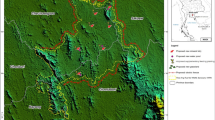Abstract
Protected areas are often the source of agricultural pests and Xishuangbanna State Nature Reserve in Yunnan is no exception. The main pest associated with the reserve is the Asian elephant Elephas maximus which causes damage outside the reserve to agriculture and also within the reserve. These elephants are an important attraction for tourists visiting Xishuangbanna. Xishuangbanna prefecture contains the only remaining wild elephants in China. The present direct economic value of tourism within the reserve is much less than the loss resulting from the economic damage caused by the elephants and other species protected by it. Whether the net economic value of protecting this species in Xishuangbanna is positive depends on other factors or future tourism prospects. Methods of controlling pests from the reserve are discussed, as is the scheme for compensating agriculturalists for the damage caused by these pests. The problem of achieving an equitable solution to the pest problem is given considerable attention. The economics of reconciling the conflicting interests of those who either regard a species as a pest or as an asset are considered.
Similar content being viewed by others
References
Barbier, E.B., Burgess, J.C., Swanson, T.M. and Pearce, D.W. (1990). Elephants, Economics and Ivory. London: Earthscan.
Brown, G. and Henry, W. (1989) The Economic Value of Elephants. London: London Environmental Economics Centre.
Clark, C.W. (1990) Mathematical Bioeconomics: The Optimal Management of Renewable Resources, 3rd edn. New York: John Wiley.
Coase, R. (1960) The problem of social cost. J. Law Econ. 3, 1-44.
Conrad, J.N. and Clark, C.W. (1987). Natural Resource Economics: Notes and Problems. Cambridge: Cambridge University Press.
Driml, S. and Common, M. (1995) Economic and financial benefits of tourism in major protected areas. Aust. J. Environ. Manage. 2(1), 19-29.
Hardin, G. (1960) The competitive exclusion principle. Science 141, 1291-7.
Hardin, G. (1968) The tragedy of the commons. Science 162, 1243-7.
Headley, J.C. (1972) Defining the economic threshold. In Pest Control Strategies for the Future, (Agricultural Board, Division of Biology and Agriculture, National Research Council, eds) pp.100-8. Washington, DC: National Academy of Sciences.
Mittermaier, R.A. and Werner, T.B. (1990) World of plants and animals in megadiversity countries. Tropicus 4(1), 1, 4-5.
Myers, N. (1988) Threatened biota: hotspots in tropical forests. The Environmentalist 8(8), 1-20.
Pearce, D.W., Markandya, A. and Barbier, E.B. (1989) Blueprint for a Green Economy. London: Earthscan.
Repetto, R. and Gillis, M. (1988) Public Policies and the Misuse of Forest Resources. Cambridge: Cambridge University Press
Sukumar, R. (1989) The Asian Elephant: Ecology and Management. Cambridge: Cambridge University Press.
Swanson, T.M. (1994) The International Regulation of Extinction. New York: New York University Press.
Thouless, C.R. and Sakwa, J. (1995) Shocking elephants: fences and crop raiders in the Laikipia District, Kenya. Biol Conservat 72, 92-107.
Tisdell, C.A. (1982) Wild Pigs: Environmental Pest or Economic Resource? Sydney: Pergamon.
Tisdell, C.A. (1991) Economics of Environmental Conservation. Amsterdam: Elsevier.
Tisdell, C.A. and Zhu, X. (1995) Protected Areas, Agricultural Pests and Economic Damages. Brisbane: Department of Economics, The University of Queensland.
Author information
Authors and Affiliations
Rights and permissions
About this article
Cite this article
Tisdell, C., Zhu, X. Protected areas, agricultural pests and economic damage: conflicts with elephants and pests in Yunnan, China. The Environmentalist 18, 109–118 (1998). https://doi.org/10.1023/A:1006674425017
Issue Date:
DOI: https://doi.org/10.1023/A:1006674425017




